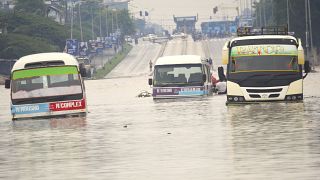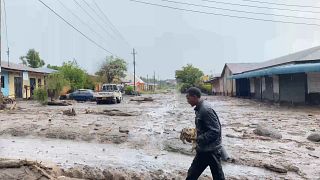East Africa
Footage of impassible roads continue to come from Ethiopia, Kenya and Tanzania among other countries in East Africa.
Speaking from New York Thursday (May 2nd), a spokesperson for the United Nations' chief, Antonio Guterres, reiterated the UN's readiness to provide additional support to national authorities.
Stéphane Dujarrik also extended Antonio Guterres’ condolences to those affected.
“The Secretary-General’s expressed his deep distress at the news of the hundreds of lives lost and many others affected by the heavy flooding in Burundi, in Kenya, Somalia and Tanzania, as well as other parts of East Africa," Dujarrik told reporters.
"The United Nations and its partners are working closely with national authorities to address humanitarian requirements. The Secretary-General stresses that the United Nations stands ready to offer any additional assistance that may be needed during this difficult period. The Secretary-General is extremely concerned about the impacts of El Niño-triggered extreme weather, which risk further devastating communities and undermining livelihoods.”
Why are rains so intense?
The devastating rains in the region are a result of a mix of factors, including the countries' seasonal weather patterns, human-caused climate change as well as natural weather phenomena such as El-Nino.
In Kenya's case, the Indian Ocean Dipole (IOD), a naturally occurring climate system has been cited by researchers.
The IOD is a swinging of sea surface temperatures that makes the western Indian Ocean warmer than average then colder than average than those of the eastern Indian Ocean. It has positive, neutral and negative phases.
The positive phase causes heavy rainfall in areas west of the Indian Ocean, such as Kenya, and droughts in Indonesia and Australia.
READ ALSO: What's causing the catastrophic rainfall in Kenya?
Joyce Kimutai, a research associate at Imperial College London says it’s highly likely that the positive IOD and climate change explain the ongoing flood-inducing rainfall.
Warmer oceans caused by the hotter atmosphere increase evaporation, and air holding more moisture can produce more intense rainfall.
In an analysis in December last year, Kimutai and colleagues from World Weather Attribution, a group of scientists that analyze whether climate change played a role in extreme weather, found that human-caused climate change had made last year’s “short rains” season in Kenya and other parts of eastern Africa up to two times more intense.













Go to video
Sub-Saharan Africa’s economy set to rebound, but Jobs still a major hurdle
Go to video
2025 Shanghai half marathon sets new records
Go to video
US official reaffirms Washington's commitment to peace in East Africa during Rwanda visit
Go to video
Africa off track on maternal mortality targets, UN warns on world health day 2025
Go to video
UN intensifies patrols at displacement camps amid rising violence in South Sudan
00:29
UN details 137 percent increase in aid workers deaths